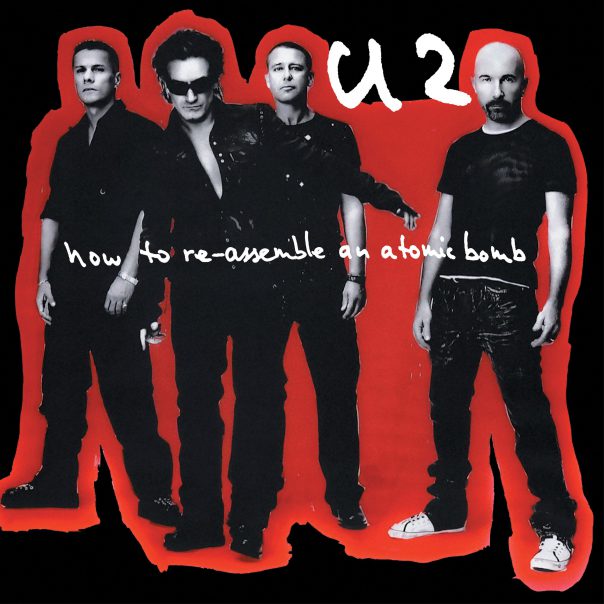REVIEW: U2 dismantle, re-assemble and reissue their atomic bomb

U2, “How To Re-Assemble An Atomic Bomb.”
Rock and roll is dead? Please. Every year, the “Kids Don’t Care About Guitars Anymore” narrative drives clicks—or, in the ancient times, sold magazines. Inevitably, Newton’s Third Law kicks in, and guitar bands, both new and old, push back with equal force.
How to Re-Assemble an Atomic Bomb
U2
Interscope, Nov. 22
8/10
Get the album on Amazon Music.
In the early 2000s, the “action” was Timberlake, Timbaland and a newly solo Beyoncé. The “reaction” came in the form of bands like The Hives, Jet, The Vines and The White Stripes.
During this time, the biggest guitar band in the world also had physics on the brain. U2 was hard at work in the studio, linking Einstein’s mass-energy equivalence formula to its sessions for How to Dismantle an Atomic Bomb, its 11th studio album. Released in 2004, the album hit no. 1 in 34 countries, sold nearly 10 million copies and won eight Grammys.
For U2, E = mc² + U2 was a winning formula both creatively and culturally. The fourth-generation iPod launched with an iconic ad campaign featuring single “Vertigo.” While future collaborations with Apple would be more of a bust than a bang, in 2004, U2 was a symbol of loud guitars roaring back into the zeitgeist—and succeeding wildly.
The death of rock would have to be postponed. Again.
Now, U2 is celebrating the 20th anniversary of How to Dismantle an Atomic Bomb with the requisite remaster and re-release. Alongside the remastered original album is How to Re-Assemble an Atomic Bomb, a “shadow album” comprising mostly unreleased material from those early 2000s sessions. These tracks, discovered by The Edge while digging through the archives, offer a fresh perspective on that era.
The results may leave some fans wondering how these songs were left behind. While this collection lacks a track as immediate and focused as “Vertigo,” several songs stand toe-to-toe with the originals from 20 years ago.
“Evidence of Life” is an aggressive rocker sung by The Edge. Built around one of his angriest riffs and a simple, repeating synth pattern, its closest cousin would be “All Because of You”—but this track is rawer and more vitriolic.
Other tracks maintain the guitar-forward approach that defined the original album. “Happiness” chugs along with a crunchy four-on-the-floor groove and a shouted call-and-response chorus, with Bono declaring, “We’re here for the atomic bomb.” A fiery wah-wah guitar solo seals the deal toward the end. It’s borderline silly but forgivable—it’s clear the band is having a blast.
“Treason” stands out as more of an edge case than an Edge showcase. It’s the most experimental track in the collection, featuring staccato synth string stabs over a syncopated drum machine loop and minimal instrumentation. Bono’s melody takes center stage until Larry Mullen, Jr.’s drums and The Edge’s guitar join in, adding urgency to Bono’s rapid-fire delivery. It’s a reminder of how rewarding it can be when U2 embraces its weirdness. It doesn’t always work, but it’s never boring.
RELATED STORIES:
• Despite fancy Las Vegas Sphere, U2 reaffirms its strengths lie in connection
• U2 unplugs (mostly) on ‘Songs of Surrender’ experiment
• Two U2 nerds on the significance of ‘All That You Can’t Leave Behind,’ 20 years later
• Mortality looms large over U2’s ‘Songs of Experience’
• U2 makes the grade on ‘Songs of Innocence’
• U2 pulls a rabbit out of a hat on ‘No Line on the Horizon’
The centerpiece of the collection is “The Luckiest Man in the World,” a reworking of fan-favorite “Mercy.” The song, which leaked years ago on a U2 fan forum and became a cult classic, finally gets an official release. For a band that prides itself on reinvention, this track is a celebration of U2 sounding like U2. With a soaring vocal and a slow-building arrangement that culminates in a stadium-ready chorus, it evokes the grandeur of “Where the Streets Have No Name” and “City of Blinding Lights.” The melody is a knockout, though the re-recorded vocals hint at why the band shelved the track for so long. The vague, disconnected lyrics reveal that Bono never quite cracked its meaning—but with such gorgeous delivery, it’s hard to care.
“Country Mile” comes closest to being single-worthy, featuring a chorus so hooky that it audaciously opens the track. Warm and emotionally resonant, it captures the best qualities of U2’s output in this millennium.
If you listen closely, you’ll hear shared elements—drum patterns, melodies, lyrical fragments—woven throughout both Dismantle and Re-Assemble. Ideas drift between songs like atoms divided and recombining. U2’s songwriting process is one of fission and fusion, and this peek into the band’s laboratory is revealing and rewarding. When all the elements come together, it has enough explosive moments to live on its own merits.
